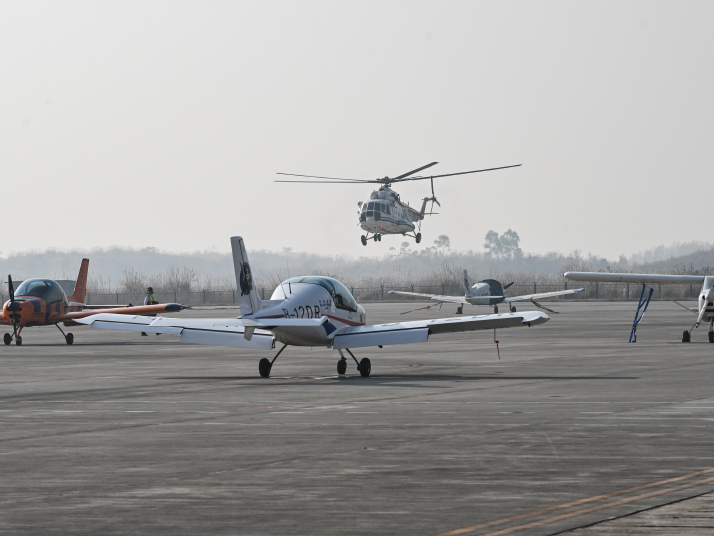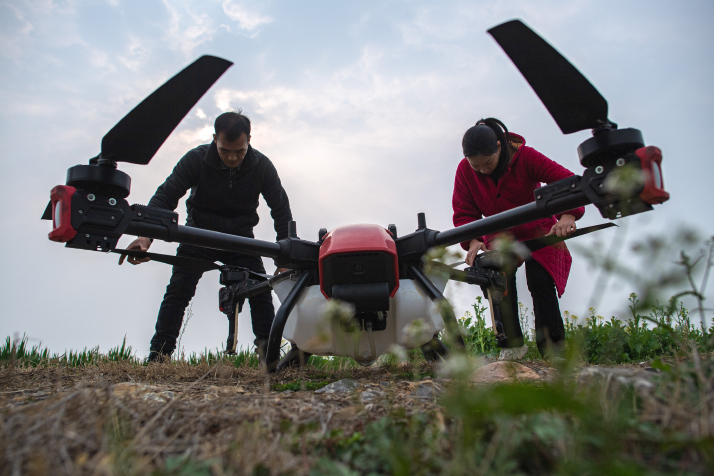| Business |
| China's low-altitude economy is ready for takeoff | |
|
|
 A helicopter lands at an airport in Jintang County, Sichuan Province in southwest China, on December 24, 2023, the day when two low-altitude air routes linking Jintang and other regions in the province opened (XINHUA)
In Shenzhen, Guangdong Province, a city known for its tech innovation, residents have recently adopted helicopters as "air taxis" alongside buses, cabs and the subway. On board these air taxis, passengers are treated to panoramic views of the city's picturesque landscapes, making their journeys both convenient and alluring. While a 40-km terrestrial journey can take up to an hour in optimal traffic conditions, an air taxi can cover the same distance in a mere 10 minutes. Boarding these innovative taxis requires a visit to the top floor of a 40-story skyscraper, where passengers undergo training and security checks. Over the past year, Shenzhen has inaugurated several intercity air taxi routes, whisking commuters away to neighboring destinations like Guangzhou and Zhuhai, significantly shortening travel times. In Shenzhen, it's not just people who have embraced the sky travel. Goods are now also being delivered within the city by air. So, if one day you receive a delivery from a drone, don't be startled. In recent years, low-altitude flying machines (flying below 3,000 meters), represented by helicopters and drones, have been weaving their way into the fabric of people's lives. The pathways they navigate are emerging as a fresh urban ring-road, a new layer intertwining with the cityscape. Once only scenes from science fiction, visions of hovering aircraft in the city skies are gradually becoming a reality. Behind these advancements lies a vast and promising expanse—the low-altitude economy, which refers to a realm of industries centered around civil manned and unmanned aerial vehicles, including manufacturing, helicopter or drone operations, and integrated services.  Two farmers adjust a crop protection unmanned aerial vehicle before flying it in a village in Tianmen, Hubei Province, on March 1, 2023 (XINHUA)
A blue ocean Over 120 years ago, the Wright brothers successfully conducted the world's first flight with the aircraft Wright Flyer. The advent of airplanes transformed the expansive sky into a new economic resource. However, the extensive sky is predominantly utilized in the mid-to-high altitude range by civil aviation and related industries, leaving the lower airspace currently untapped. "The low-altitude economy holds vast prospects," Xiang Zheng, Deputy Secretary General and Director of Beijing Liaison Office of Shenzhen Unmanned Aerial Vehicle Industry Association, told Beijing Review. "The rapid technological iteration, coupled with a multitude of versatile use cases, bestows upon the low-altitude economy enormous potential and a vast realm of imaginative possibilities." The development of major cities is increasingly constrained by ground-level limitations, prompting a growing trend toward exploration and extension into the airspace. Low-altitude regions represent an incremental space within the geographical spectrum, he said. Industry insiders suggested that the low-altitude sector may become a trillion-dollar industry earlier than the autonomous driving industry. "In contrast to autonomous driving cars, low-altitude vehicles do not pose conflicts with existing traffic structures," Xiang said. "And many countries demonstrate a relatively open attitude toward them. Consequently, the industry is experiencing rapid momentum." According to a white paper published last November by the International Digital Economy Academy in Shenzhen, the low-altitude economy could contribute 3-5 trillion yuan ($419.9-699.8 billion) to China's economy by 2025. The white paper also highlighted that the return on investment for projects within this sector will be notably high. Currently, traditional infrastructure investment faces growth constraints. In this context, low-altitude infrastructure construction is expected to stimulate effective investment. The low-altitude economy has emerged as a new arena for competition among the world's major economic players. "China holds an unequivocal leading position internationally in the field of new low-altitude economic products and technologies, represented by drones and electric vertical takeoff and landing (eVTOL) vehicles," Xiang said. "They are emerging as China's new 'technological signature'." China currently commands a market share of over 70 percent in the global drone market. Chinese eVTOL companies, represented by EHang and Autoflight, are setting industry benchmarks in the global market. 'Braving uncharted territories' China has placed significant importance on developing the low-altitude economy in recent years and, in 2021, the concept of the low-altitude economy was formally integrated into the country's development plan. Since then, the low-altitude economic sector has experienced rapid growth. According to the Civil Aviation Administration of China, as of August 2023, the country had over 1.11 million registered civilian unmanned aerial vehicles, increasing nearly 16 percent from 2022. The number of drone pilot licenses issued has reached 182,000, and there are more than 17,000 registered drone-operating enterprises. During the recently concluded Central Economic Work Conference, held in December last year, the low-altitude economy was listed as one of the strategic emerging industries alongside bio-manufacturing and commercial aerospace. Last year, 16 provinces included the low-altitude economy, general aviation and other related concepts in their government work reports. Cities including Shenzhen, Hefei, Guangzhou, Chengdu and others are rolling out policy incentives, vying for the prestigious title of "leading city in the low-altitude economy." In addition to drone and eVTOL enterprises, companies with an Internet-based DNA are also accelerating their efforts to establish a footprint in the low-altitude economy. In 2022, logistics firm SF Express became the first in China to obtain a license to test regional unmanned aerial vehicles; online delivery platform Meituan won approval to start commercial drone delivery operation in 2023; and e-commerce giant JD.com's drones are already operational in many regions in China. "The low-altitude economy is experiencing a rare strategic opportunity. Favorable policy support, accelerated corporate convergence, diverse application scenarios, robust market demand, mature technological foundations and evident core advantages all contribute to this opportune period," Xiang said. However, the development of the low-altitude economy is challenged by a complex and underdeveloped regulatory system, a need for strengthened supply chain development, urgent requirements for infrastructure improvement and the necessity to enhance regulatory standards, he said. "The large-scale application of the low-altitude products and technologies is a complex process, which may take at least three to five years," Xiang said, adding that fine-tuned airspace management, networked route construction, standardized institutional mechanisms and systematized regulatory standards are all necessary conditions for achieving scalable development. There is currently no mature economic model or readily available business format to draw inspiration from. The exploration of new economic development paths, akin to braving uncharted territories, requires continuous, long-term and iterative practical exploration, he said. (Print Edition: A High-Flyer in the Making) Copyedited by G.P. Wilson Comments to zhangshsh@cicgamericas.com |
|
||||||||||||||||||||||||||||
|